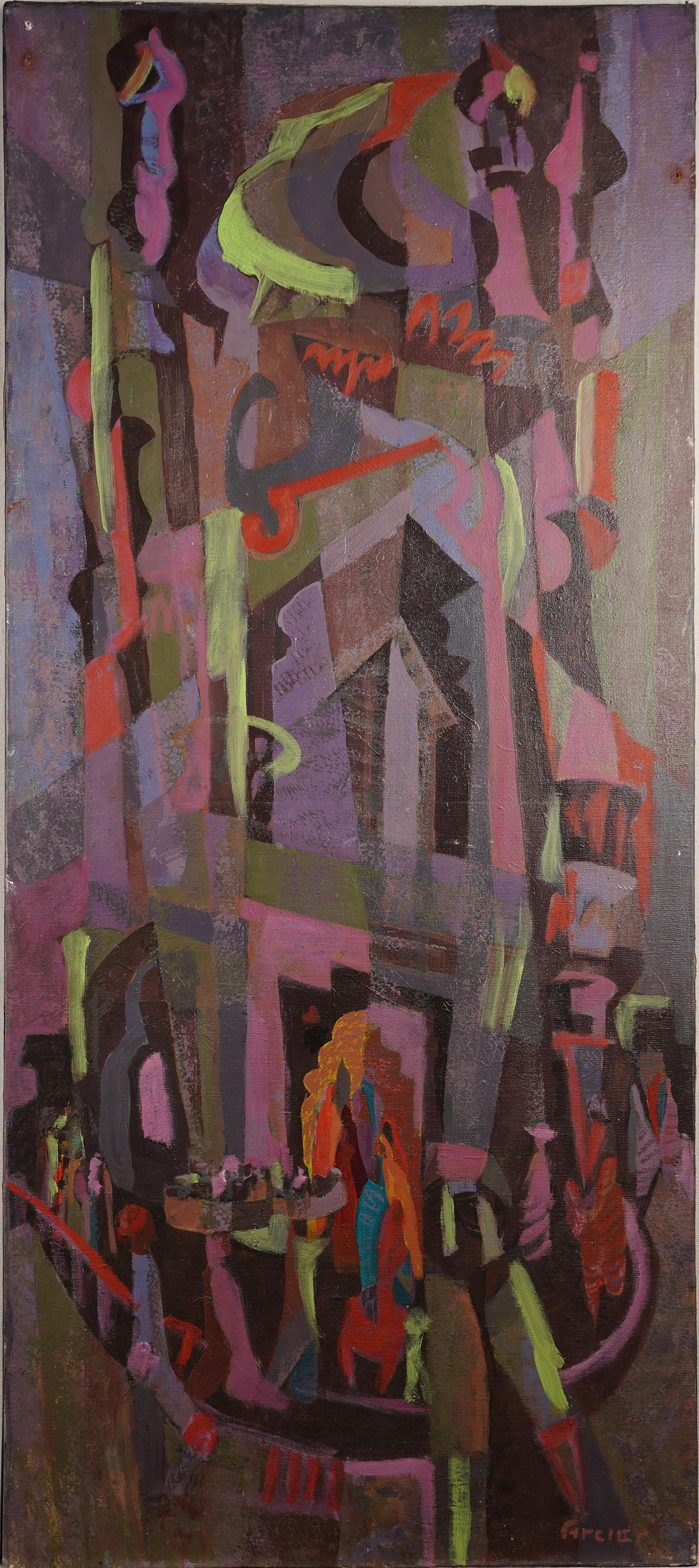Items Similar to A Cubist French City, 1919
Want more images or videos?
Request additional images or videos from the seller
1 of 7
Dick BeerA Cubist French City, 19191919
1919
About the Item
Dick Beer (b. London 1893 - d. Stockholm 1938)
A French City, 1919 (Fransk stad)
oil on canvas
canvas dimensions 82x66 cm
frame 94x78.5 cm
signed Dick Beer
painted 1919
Exhibited:
Gothenburg Art Gallery, Memorial exhibition, 1944;
Åmells Konsthandel – En internationell kubist, Stockholm & London, 2008;
Provenance:
Within the family Beer until today
Cubistic vision:
In the period following the First World War, the artist’s painting underwent a fundamental transformation. Dick Beer was influenced by various modernistic expressions. In Paris, the first wave of cubism, led by Pablo Picasso and Georges Braque, was established. It was a controversial artistic style. There was a heated debate about cubism, in which the artist broke up the motif into smaller components, sometimes called facets, in order to rebuild it on the flat surface of the pictorial plane. This manner of painting represented a complete break with preceding pictorial conventions and naturalistic painting.
Cubism was governed by theory, not practice, and critics claimed that the style was too intellectual for the general public and they predicted that it would disappear and that artists would return to a rather more classic expression.
The theories surrounding cubism and its various expressions opened up for a number of reinterpretations in the 1910s. Dick Beer was well aware of the cubist discussions. He embraced the ideas but created a varied, personal and emotive cubism in the years around 1918. His painting was often an explosive discharge with playful characteristics and a futuristic dynamism which accentuated the painting’s inherent speed and movement, as for example his works “Dancer” and “The Toy Box”. He also experimented with geometric compositions of buildings and landscapes, which were reminiscent of Paul Cézanne’s more cubic landscapes. Here, Beer’s colours were often muted, in blue, brown and red hues. He frequently returned to earlier motifs and reworked his canvases into a cubist style, as in “Dancer tying her shoes” and “Seated dancer“.
Contemporary art critics were appalled and Beer had to endure severe criticism. At one point, the artist published a reply in the daily Politiken, 1919, where he described his view on art:
“... because love for and understanding of art, ‘l’art pour l’art’, is not easy to achieve, and neither is it easy to comprehend the different movements’ or schools’ origin, goals, characteristic endeavours, etc. – These international phenomena require not only theoretical and art historical knowledge but (...) the ability to empathise with and feel for art, as its practitioners do”.
- Creator:Dick Beer (1893 - 1938, Swedish, British)
- Creation Year:1919
- Dimensions:Height: 32.29 in (82 cm)Width: 25.99 in (66 cm)
- Medium:
- Movement & Style:
- Period:
- Condition:Very good, ready to hang.
- Gallery Location:Stockholm, SE
- Reference Number:1stDibs: LU1445212003682
About the Seller
5.0
Platinum Seller
These expertly vetted sellers are 1stDibs' most experienced sellers and are rated highest by our customers.
Established in 2020
1stDibs seller since 2020
121 sales on 1stDibs
Typical response time: <1 hour
Associations
International Confederation of Art and Antique Dealers' Associations
- ShippingRetrieving quote...Ships From: Stockholm, Sweden
- Return PolicyA return for this item may be initiated within 2 days of delivery.
More From This SellerView All
- Cubist Painting By Swedish Artist Dick Beer, View From a Window, 1920Located in Stockholm, SEDick Beer (b. London 1893 - d. Stockholm 1938) Utsikt från fönster, View From a Window, 1920 oil on canvas 73 x 60.5 cm stamp signed painted 1920 Exhibi...Category
1920s Cubist Abstract Paintings
MaterialsCanvas, Oil
- Cubist Painting from 1918-19, Portrait of Dr Mens IIILocated in Stockholm, SEDick Beer (b. London 1893 - d. Stockholm 1938) Portrait of Dr Mens III, 1918-1919 oil on board 70 x 50 cm stamp signed painted c. 1918-1919 Provenance: Within the family Beer until today Dick Beer (1893-1938) Dick Beer was born in London in 1893. His father, John Beer (1853-1906), was a Swedish painter from Stockholm who had a career mainly as a watercolour painter with motifs of horses from racetracks and fox hunts from the countryside. Barely fifteen years old, Dick Beer became an orphan and came to Sweden in 1907. Already in 1908-1909, he started at Althin's painting school in Stockholm. And later, at the Royal Academy of Arts from 1910-1912. His teachers were, among others, Gustaf Cederström, Oscar Björk and Alfred Bergström...Category
1910s Cubist Portrait Paintings
MaterialsOil, Board
- Autumn Landscape by Swedish Impressionist Painter Axel Zachrisson, c. 1920Located in Stockholm, SEThis exquisite painting by Axel Zachrisson, a Swedish artist, offers a serene glimpse into the tranquil beauty of Dalsland, Sweden. Created around 1920, the artwork captures the esse...Category
1920s Naturalistic Landscape Paintings
MaterialsCanvas, Oil
- Oil Painting Depicting a Birch Forest, Karlberg, Kungsholmen, StockholmLocated in Stockholm, SEPainted in 1909, this artwork depicts a scene from Karlberg, located on Kungsholmen (Stockholm). The focal point is a majestic birch forest, with tall and...Category
Early 1900s Post-Impressionist Landscape Paintings
MaterialsCanvas, Oil
- Stockholm Winter Landscape, 1919, by Swedish Artist Anton GenbergLocated in Stockholm, SEWe are honored to present for sale a captivating winter landscape painting by Anton Jonsson Genberg, completed in 1919. This piece is a pristine representation of Genberg's artistry,...Category
1910s Impressionist Landscape Paintings
MaterialsCanvas, Oil
- Lost in Thoughts, Oil Sketch Painted in Brittany (Bretagne), Before 1890Located in Stockholm, SEWe are delighted to offer a unique and evocative piece by the Swedish artist Ingeborg Westfelt-Eggertz. This small oil sketch captures a moment in time, portraying a young man seated...Category
1880s Landscape Paintings
MaterialsCanvas, Masonite, Oil
You May Also Like
- "The Colorful Florence" Contemporary Cubist Abstract LandscapeBy Masri HayssamLocated in Carmel, CA"The Colorful Florence," a 20" x 28" oil on canvas by Masri, captures the essence of a pastoral landscape through a dynamic abstract lens. In this piece, the earth is alive with rich...Category
21st Century and Contemporary Cubist Landscape Paintings
MaterialsOil, Canvas
- Vintage Large Signed Abstract Expressionist Framed Modern Indian Space PaintingLocated in Buffalo, NYVery impressive early abstract painting by Peter Busa (1914 - 1985). Oil on canvas. Signed lower left. Housed in a period modernist frame.Category
1950s Cubist Abstract Paintings
MaterialsCanvas, Oil
- Antique American Textural Abstract Expressionist Framed Signed NY Oil PaintingLocated in Buffalo, NYNicely painted mid century modern abstract expressionist textural oil painting. Great color and composition. Framed. No signature found.Category
1960s Cubist Abstract Paintings
MaterialsCanvas, Oil
- American Impressionist Cityscape Framed Signed Central Park Castle Oil PaintingLocated in Buffalo, NYNicely painted mid century impressionist cityscape oil painting. Great color and composition. Framed. Signed.Category
1960s Cubist Abstract Paintings
MaterialsCanvas, Oil
- Huge Rare Vintage American School Cubist Abstract Pop Art Abstract Oil PaintingLocated in Buffalo, NYVintage signed large abstract oil painting. Oil on canvas. Signed.Category
1940s Cubist Landscape Paintings
MaterialsCanvas, Oil
- Sea Garden, Teresa Pemberton, Original Abstract Seascape Painting, Bright ArtBy Teresa PembertonLocated in Deddington, GBTeresa Pemberton Sea Garden Original Oil Painting Oil Paint on Canvas Size: H 100cm x W 100cm x D 3.5cm Sold Unframed Please note that in situ images are purely an indication of how ...Category
21st Century and Contemporary Cubist Abstract Paintings
MaterialsCanvas, Oil
Recently Viewed
View AllMore Ways To Browse
Antique Contemporary Art
Antique Abstract
1919 Painting
Antique Paintings City
Cubist French Art
French Cubist Artists
French Cubist Painting
Framed Cubist Art
Oil Painting 1919
Cubist Style Paintings
London 1919
Cubist School
Abstract Art Antique
Antique Abstract Art
Paris Cubist Painting
Cubist City
Blue Cubist
Abstract Cubism Cubist




